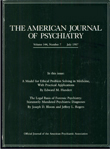Comparison of patients with early-, typical-, and late-onset affective psychosis
Abstract
OBJECTIVE: The authors compared the clinical characteristics and family history of patients with early-onset (before age 18), typical-onset (at 20-25 years), and late-onset (after age 35) affective psychosis at the time of first hospitalization. METHOD: Diagnostic, symptom, and family history information was obtained from 88 consecutively hospitalized patients. RESULTS: Major depression was more common in the late-onset group, and a family history of affective and substance abuse disorders was more common among the early-onset patients. Affective symptoms differed significantly among groups; specifically, early-onset patients had more energy, minimal sleep disruption, and greater suicidality, while typical-onset patients had more severe abnormal thought content. CONCLUSIONS: Among patients with affective psychosis, there may be heterogeneity of symptoms and family history associated with age at first hospitalization.



